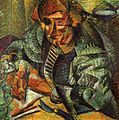Antigrazioso or L'antigrazioso (Italian for "The Anti-graceful"), also known as The Mother (La madre), is a patinated gesso sculpture by Umberto Boccioni realized between 1912 and 1913; it is located in the Galleria nazionale d'arte moderna e contemporanea of Rome.[1]
The bust is one of the few surviving examples of Futurist sculptures made by Boccioni in 1912 and 1913 and exhibited at the Galerie 23 in Paris in 1913.
History

The original gesso, exhibited since 1938 in the Galleria nazionale d'arte moderna, was acquired in 1950 by the museum from Benedetta Marinetti.[1]
Description
The sculpture represents the futurist decomposition of the face of the artist's beloved mother, also portrayed in the 1913 painting Materia. Boccioni also executed a 1913 painting with the same title, Antigrazioso, but with a different setting.
The sculpture has a similar style of Unique Forms of Continuity in Space.[2]
-
Umberto Boccioni, L'antigrazioso, painting, 1912
Bronze cast
In 1950-1951, a bronze casting of the artwork was made. It was acquired and exhibited by the Metropolitan Museum of New York.
See also
References
- ^ a b "Gli artisti e le opere". www.gnamdrive.beniculturali.it (in Italian). 7 March 2013. Archived from the original on 28 March 2017. Retrieved 2017-03-27.
- ^ Emanuela Calura (2016). Poetiche del Novecento: Lezioni /Appunti didattici (in Italian). Lampi di stampa. pp. 24–. ISBN 978-88-488-1824-7.
External links
- "Gli artisti e le opere". www.gnamdrive.beniculturali.it (in Italian). 7 March 2013. Archived from the original on 28 March 2017. Retrieved 2017-03-27.










You must be logged in to post a comment.